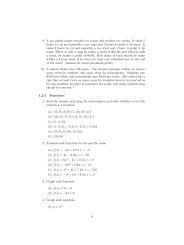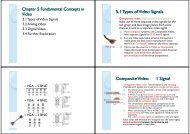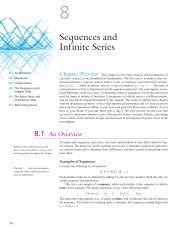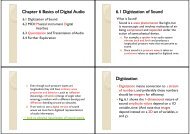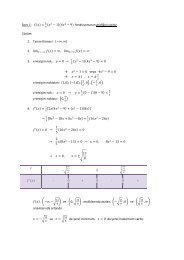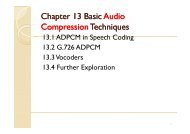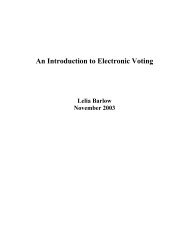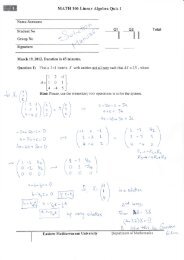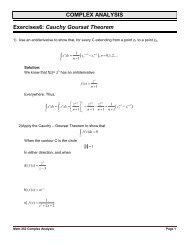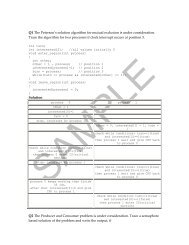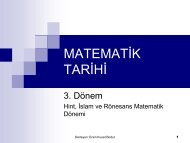Exercises
Exercises
Exercises
Create successful ePaper yourself
Turn your PDF publications into a flip-book with our unique Google optimized e-Paper software.
Ch. 12 Graphing and Optimization<br />
12.1 First Derivative and Graphs<br />
1 Increasing and Decreasing Functions<br />
SHORT ANSWER. Write the word or phrase that best completes each statement or answers the question.<br />
Provide an appropriate response.<br />
1) Indentify the intervals where f(x) is increasing.<br />
2) Indentify the intervals where f′(x) < 0.<br />
Page 222
MULTIPLE CHOICE. Choose the one alternative that best completes the statement or answers the question.<br />
Use the given graph of f(x) to find the intervals on which f′(x) > 0.<br />
3)<br />
4)<br />
25<br />
20<br />
15<br />
10<br />
5<br />
y<br />
-7 -6 -5 -4 -3 -2 -1<br />
-5<br />
-10<br />
-15<br />
-20<br />
-25<br />
1 2 3 4 5 6 7 x<br />
A) f′(x) > 0 on [-3, ∞), f′(x) < 0 on decreasing on (-∞, -3]<br />
B) f′(x) < 0 on (-∞,∞)<br />
C) f′(x) > 0 on (-∞, -7] ∪ [1, ∞), f′(x) < 0 on [-7, 1]<br />
D) f′(x) > 0 on [-7, ∞), f′(x) < 0 on (-∞, -7]<br />
500<br />
400<br />
300<br />
200<br />
100<br />
y<br />
-10 -8 -6 -4 -2<br />
-100<br />
-200<br />
-300<br />
-400<br />
-500<br />
2 4 6 8 10<br />
A) f′(x) > 0 on [-5, 5], f′(x) < 0 on (-∞, -5] ∪ [5, ∞)<br />
B) f′(x) > 0 on (-∞, -5] ∪ [5, ∞), f′(x) < 0 on [-5, 5]<br />
C) f′(x) > 0 on (-∞, 5], f′(x) < 0 on [5, ∞)<br />
D) f′(x) > 0 on [-25, 25], f′(x) < 0 on (-∞, -25] ∪ [25, ∞)<br />
x<br />
Page 223
Provide an appropriate response.<br />
5) Find the critical values and determine the intervals where f(x) is increasing and the intervals where f(x) is<br />
decreasing for the function f(x) = x3 + 3x2 - 24x + 6.<br />
A) increasing on (-∞, -4) ∪ (2, ∞); decreasing on (-4, 2)<br />
B) decreasing on (-∞, -4) ∪ (2, ∞); increasing on (-4, 2)<br />
C) increasing on (-∞, -4); decreasing on (-4, 2)<br />
D) increasing on (-∞, -4) ∪ (2, ∞); decreasing on (-4, ∞)<br />
6) Determine the intervals for which the function f(x) = x3 + 18x2 + 2, is decreasing.<br />
A) (-12, 0) B) (-∞, -12) ∪ (0, ∞) C) (-∞, -12) ∪ (-12, 0) D) (0, 12) ∪ (12, ∞)<br />
7) Determine the interval(s) where f(x) = x2<br />
is decreasing.<br />
x - 3<br />
A) (0, 3) ∪ (3, 6) B) (0, 6) C) (-∞, 0) ∪ (6, ∞) D) (0, 3) ∪ (6, ∞)<br />
8) Find the critical values and determine the intervals where f(x) is decreasing and the intervals where f(x) is<br />
increasing for f(x) = 3x4 - 6x2 + 7.<br />
A) increasing on (-1, 0) ∪ (1, ∞); decreasing on (-∞, -1) ∪ (0, 1)<br />
B) decreasing on (-1, 0) ∪ (1, ∞); increasing on (-∞, -1) ∪ (0, 1)<br />
C) increasing on (-1, 0); decreasing on (-∞, -1) ∪ (0, 1)<br />
D) decreasing on (-1, 0) ∪ (1, ∞); increasing on (-∞, -1)<br />
9) Use a graphing utility to approximate the intervals where f(x) is decreasing and intervals where f(x) is<br />
increasing for the function f(x) = x4 - 3x3 - 2x2 + 5x. Round your answer to two decimal places.<br />
A) decreasing on (-∞, -0.82) ∪ (0.62, 2.45); increasing on (-0.82, 0.62) ∪ (2.45, ∞)<br />
B) increasing on (-∞, -0.82) ∪ (0.62, 2.45); decreasing on (-0.82, 0.62) ∪ (2.45, ∞)<br />
C) decreasing on (-∞, -0.82); increasing on (-0.82, 0.62)<br />
D) increasing on (-∞, -0.82); decreasing on (-0.82, 0.62)<br />
10) Find the critical values and determine the intervals where f(x) is increasing and f(x) is decreasing if<br />
f(x) = 1 + 3 2<br />
+<br />
x x2 .<br />
A) increasing on - 4<br />
4<br />
, 0 ; decreasing on -∞, -<br />
3 3<br />
B) decreasing on - 4<br />
4<br />
, 0 ; increasing on -∞, -<br />
3 3<br />
∪ (0, ∞)<br />
∪ (0, ∞)<br />
C) increasing on (-4, 0); decreasing on (-∞, -4) ∪ (0, ∞)<br />
D) decreasing on (-4, 0); increasing on (-∞, -4) ∪ (0, ∞)<br />
Page 224
11) Find the critical values and determine the intervals where f(x) is decreasing for f(x) = 3(x - 4)2/3 + 6.<br />
A) f(x) is decreasing on (-∞, 4); increasing on (4, ∞)<br />
B) f(x) is increasing on (-∞, 4); decreasing on (4, ∞)<br />
C) f(x) is decreasing on (-∞, 6); increasing on (6, ∞)<br />
D) f(x) is decreasing on (-∞, -4); increasing on (-4, ∞)<br />
12) The percent of concentration of a certain drug in the bloodstream x hr after the drug is administered is given by<br />
4x<br />
K(x) = . How long after the drug has been administered is the concentration a maximum? Round<br />
x2 + 36<br />
answer to the nearest tenth, if necessary.<br />
2 Local Extrema<br />
A) 6 hr B) 3.6 hr C) 4 hr D) 1.8 hr<br />
MULTIPLE CHOICE. Choose the one alternative that best completes the statement or answers the question.<br />
Provide an appropriate response.<br />
1) Use the first derivative test to determine the local extrema, if any, for the function: f(x) = 3x4 - 6x2 + 7.<br />
A) local max at x = 0 and local min at x = -1 and x = 1<br />
B) local min at x = 0 and local max at x = -1 and x = 1<br />
C) local max at x = 1 and local min at x = 0<br />
D) local max at x = -1 and local min at x = 0 and x = 1<br />
2) Given f(x) = x + 16<br />
, x < 0, find the values of x corresponding to local maxima and local minima.<br />
x<br />
A) local maximum at x = -4 (no local minimum)<br />
B) local minimum at x = -4 (no local maximum)<br />
C) local maximum at x = -4, local minimum at x = 4<br />
D) no local maximum or minimum<br />
3) Use a graphing utility to approximate where the local extrema of the function f(x) = x4 - 3x3 - 2x2 + 5x are to<br />
two decimal places.<br />
A) local max at x ≈ 0.62; local min at x ≈ -0.82 and x ≈ 2.45<br />
B) local min at x ≈ 0.62; local max at x ≈ -0.82 and x ≈ 2.45<br />
C) local max at x ≈ 0.82<br />
D) local min at x ≈ -0.62 and x ≈ 2.45<br />
4) Use the first derivative test to determine the local extrema, if any, for the function: f(x) = 3(x - 4)2/3 + 6.<br />
A) f(x) has a local minimum at x = 4. B) f(x) has a local maximum at x = 4.<br />
C) f(x) has a local minimum at 6 D) f(x) has no local extrema<br />
Page 225
3 First Derivative Test<br />
MULTIPLE CHOICE. Choose the one alternative that best completes the statement or answers the question.<br />
Provide an appropriate response.<br />
1) The critical values of f(x) = 4x3 - 48x + 24 are x = -2 and x = 2. Use the first derivative test to determine which<br />
of the critical values correspond to a local minimum.<br />
A) x = 2<br />
B) x = -2<br />
C) x = 2 and x = -2<br />
D) neither x = 2 nor x = -2 correspond to a local minimum<br />
2) Use the first derivative test to determine the local extrema, if any, for the function: f(x) = x3 + 3x2 - 24x + 6<br />
A) local max at x = - 4 and local min at x = 2 B) local max at x = - 4<br />
C) local min at x = 2 D) local max at x = 2 and local min at - 4<br />
3) The critical values of f(x) = 4x3 - 48x + 24 are x = -2 and x = 2. Use the first derivative test to determine which<br />
of the critical values correspond to a local maximum.<br />
A) x = - 2 B) x = 2 C) x = 2 and x = - 2 D) x = 0 and x = 2<br />
Sketch a graph of the function.<br />
4) f(x) = 4x2 + 24x<br />
200<br />
100<br />
y<br />
-10 -5 5 10<br />
A)<br />
-100<br />
-200<br />
200<br />
100<br />
y<br />
x<br />
-10 -5 5 10<br />
-100<br />
-200<br />
x<br />
Page 226<br />
B)<br />
200<br />
100<br />
y<br />
-10 -5 5 10<br />
-100<br />
-200<br />
x
C)<br />
200<br />
100<br />
y<br />
-10 -5 5 10<br />
-100<br />
-200<br />
5) f(x) = 2x3 + 15x2 + 24x<br />
A)<br />
y<br />
24<br />
12<br />
y<br />
x<br />
-8 -4 4 8<br />
-12<br />
-24<br />
x<br />
x<br />
Page 227<br />
D)<br />
B)<br />
200<br />
100<br />
y<br />
-10 -5 5 10<br />
-100<br />
-200<br />
24<br />
12<br />
y<br />
-8 -4 4 8<br />
-12<br />
-24<br />
x<br />
x
C)<br />
72<br />
36<br />
y<br />
-8 -4 4 8<br />
-36<br />
-72<br />
x<br />
Page 228<br />
D)<br />
432<br />
216<br />
y<br />
-8 -4 4 8<br />
-216<br />
-432<br />
x
6) f(x) = 12x - x3<br />
120<br />
80<br />
40<br />
y<br />
-10 -8 -6 -4 -2 2 4 6 8 10<br />
A)<br />
C)<br />
-40<br />
-80<br />
-120<br />
120<br />
80<br />
40<br />
y<br />
x<br />
-10 -8 -6 -4 -2 2 4 6 8 10<br />
-40<br />
-80<br />
-120<br />
120<br />
80<br />
40<br />
y<br />
-10 -8 -6 -4 -2 2 4 6 8 10<br />
-40<br />
-80<br />
-120<br />
x<br />
x<br />
Page 229<br />
B)<br />
D)<br />
120<br />
80<br />
40<br />
y<br />
-10 -8 -6 -4 -2 2 4 6 8 10<br />
-40<br />
-80<br />
-120<br />
120<br />
80<br />
40<br />
y<br />
-10 -8 -6 -4 -2 2 4 6 8 10<br />
-40<br />
-80<br />
-120<br />
x<br />
x
7) f(x) = 3x4 - 12x3<br />
200<br />
100<br />
y<br />
-4 -3 -2 -1 1 2 3 4<br />
A)<br />
C)<br />
-100<br />
-200<br />
200<br />
100<br />
y<br />
x<br />
-4 -3 -2 -1 1 2 3 4<br />
-100<br />
-200<br />
200<br />
100<br />
y<br />
-4 -3 -2 -1 1 2 3 4<br />
-100<br />
-200<br />
x<br />
x<br />
Page 230<br />
B)<br />
D)<br />
200<br />
100<br />
y<br />
-4 -3 -2 -1 1 2 3 4<br />
-100<br />
-200<br />
200<br />
100<br />
y<br />
-4 -3 -2 -1 1 2 3 4<br />
-100<br />
-200<br />
x<br />
x
8) f(x) = x4 - 2x2 + 3<br />
10<br />
8<br />
6<br />
4<br />
2<br />
y<br />
-6 -5 -4 -3 -2 -1<br />
-2<br />
-4<br />
-6<br />
-8<br />
-10<br />
1 2 3 4 5 6 x<br />
A)<br />
C)<br />
Solve the problem.<br />
10<br />
8<br />
6<br />
4<br />
2<br />
y<br />
-6 -5 -4 -3 -2 -1<br />
-2<br />
-4<br />
-6<br />
-8<br />
-10<br />
1 2 3 4 5 6 x<br />
10<br />
8<br />
6<br />
4<br />
2<br />
y<br />
-6 -5 -4 -3 -2 -1<br />
-2<br />
-4<br />
-6<br />
-8<br />
-10<br />
1 2 3 4 5 6 x<br />
B)<br />
D)<br />
10<br />
8<br />
6<br />
4<br />
2<br />
y<br />
-6 -5 -4 -3 -2 -1<br />
-2<br />
-4<br />
-6<br />
-8<br />
-10<br />
1 2 3 4 5 6 x<br />
10<br />
8<br />
6<br />
4<br />
2<br />
y<br />
-6 -5 -4 -3 -2 -1<br />
-2<br />
-4<br />
-6<br />
-8<br />
-10<br />
1 2 3 4 5 6 x<br />
9) With x representing the water temperature in degrees Celsius, S(x) = - x3 - 9x2 + 165x + 1300, 5 ≤ x ≤ 20 is an<br />
approximation to the number of salmon swimming upstream to spawn. Find the temperature that produces<br />
the maximum number of salmon.<br />
A) 5°C B) 20°C C) 6°C D) 19°C<br />
10) The Olympic flame at the 1992 Summer Olympics was lit by a flaming arrow. As the arrow moved d feet<br />
horizontally from the archer, assume that its height h(d), in feet, was approximated by the function<br />
h(d) = - 0.002d2 + 0.7d + 6.9. Find the relative maximum of the function.<br />
A) (175, 68.15) B) (350, 129.4) C) (0, 6.9) D) (175, 61.25)<br />
Page 231
4 Applications to Economics<br />
MULTIPLE CHOICE. Choose the one alternative that best completes the statement or answers the question.<br />
Solve the problem.<br />
1) The annual revenue and cost functions for a manufacturer of grandfather clocks are approximately<br />
R(x) = 480x - 0.02x2 and C(x) = 160x + 100,000, where x denotes the number of clocks made. What is the<br />
maximum annual profit?<br />
A) $1,180,000 B) $1,280,000 C) $1,380,000 D) $1,480,000<br />
2) The cost of manufacturing x electric woks in one day is given by C(x) = 2x3 -16x2 + 4x. Find the average cost<br />
per electric wok and the interval where the average cost per electric wok is decreasing.<br />
A) C(x) = 2x2 - 16x + 4; 0 < x < 4 B) C(x) = 6x2 - 32x + 4; 0 < x < 4<br />
C) C(x) = 6x2 - 32x + 4; x < 4 D) C(x) = 2x2 - 32x + 4; 0 < x < 4<br />
12.2 Second Derivative and Graphs<br />
1 Using Concavity as a Graphing Tool<br />
MULTIPLE CHOICE. Choose the one alternative that best completes the statement or answers the question.<br />
Provide an appropriate response.<br />
1) Find fʹʹ(x) for f(x) = -7x9 + 5x2.<br />
A) fʹʹ(x) = -504x7 + 10 B) fʹʹ(x) = -63x8 + 10x C) fʹʹ(x) = 504x8 + 10 D) fʹʹ(x) = 504x7 - 10<br />
2) Find fʺ(x) for f(x) = 4x - 6.<br />
A) fʺ(x) = 0 B) fʺ(x) = 4x3 - 6x2 C) fʺ(x) = 4<br />
x<br />
3) Find fʺ(x) for f(x) = 5x4 - 6x2 + 7.<br />
D) fʺ(x) = 4<br />
A) fʺ(x) = 60x2 - 12 B) fʺ(x) = 20x2 - 12 C) fʺ(x) = 60x2 - 12x D) fʺ(x) = 20x2 - 12x<br />
4) Find fʺ(x) for f(x) = (4x + 5)3 .<br />
A) fʺ(x) = 384x + 480 B) fʺ(x) = 24x + 30 C) fʺ(x) = 12x + 15 D) fʺ(x) = 4x + 5<br />
5) Find yʺ for y = -<br />
A) yʺ = -<br />
1<br />
3x + 4 .<br />
18<br />
(3x + 4)3<br />
B) yʺ = -<br />
2<br />
(3x + 4)3<br />
C) yʺ = -<br />
6<br />
(3x + 4)3<br />
6) Find yʺ for y = 2 x3/2 - 6x1/2 .<br />
A) yʺ = 3<br />
2 x- 1/2 + 3<br />
2 x- 3/2 B) yʺ = 3x1/2 - 3x- 1/2<br />
C) yʺ = 3<br />
2 x1/2 + 3<br />
2 x- 1/2 D) yʺ = 3x- 1/2 + 3x- 3/2<br />
Page 232<br />
D) yʺ =<br />
18<br />
(3x + 4)3
7) Find yʺ for y = 5x2 + 4 .<br />
A) yʺ =<br />
20<br />
(5x2 + 4) 3/2<br />
25x2<br />
C) yʺ = -<br />
(5x2 + 4) 1/2<br />
8) Find yʹʹ for y = x4 - 8x1/2<br />
A) 12x2 + 2<br />
x x<br />
B) 4x3 - 4<br />
x<br />
B) yʺ = -<br />
1<br />
4(5x2 + 4) 3/2<br />
25x2<br />
D) yʺ = -<br />
(5x2 + 4) 3/2<br />
C) 12x2 - 4<br />
x<br />
9) Determine the interval(s) over which f(x) = (x - 4)3 is concave downward.<br />
D) 4x3 + 4<br />
x<br />
A) (-∞, 4) B) (-∞, -4) C) (4, ∞) D) (-4, ∞)<br />
10) Determine the interval(s) over which f(x) = (x + 3)3 is concave upward.<br />
2 Find Inflection Points<br />
A) (-∞, -3) B) (-∞, 3) C) (-∞, ∞) D) (-3, ∞)<br />
MULTIPLE CHOICE. Choose the one alternative that best completes the statement or answers the question.<br />
Provide an appropriate response.<br />
1) Find all inflection points for f(x) = x4 - 10x3 + 24x2 + 3x + 5.<br />
A) Inflection points at x = 1, x = 4<br />
B) Inflection points at x ≈ -0.06, x ≈ 2.43, x ≈ 5.13<br />
C) Inflection points at x = 0, x = 1, x = 4<br />
D) This function does not have any inflection points.<br />
2) Find the inflection point(s) for f(x) = x3 - 6x - 1.<br />
A) (0, -1) B) (0, -6) C) (1, -1) D) (-1, 6)<br />
3) Find the inflection point(s) for f(x) = x + 7.<br />
A) (-7, 0) B) (-3, 2)<br />
C) (-6, 1) D) There are no points of inflection.<br />
4) Find the inflection point(s) for f(x) = 1<br />
4 x4 - x3 + 6.<br />
A) (0, 6) and (2, 2) B) (0, 0) and (2, 2) C) (0, 0) D) (0, 6) and (2, -4)<br />
Page 233
3 Analyzing Graphs<br />
MULTIPLE CHOICE. Choose the one alternative that best completes the statement or answers the question.<br />
Decide if the given value of x is a critical number for f, and if so, decide whether the point for x on f is a relative<br />
minimum, relative maximum, or neither.<br />
1) f(x) = ( x + 3)4; x = - 3<br />
A) Critical number; minimum at (-3 , 0) B) Critical number; maximum at (-3 , 0)<br />
C) Critical number but not an extreme point. D) Not a critical number.<br />
Sketch the graph and show all local extrema and inflection points.<br />
2) f(x) = 6x<br />
x2 + 9<br />
A) Local minimum: (-3, -1)<br />
Local maximum: (3, 1)<br />
Inflection points: (0, 0), (-3 3, - 3<br />
2<br />
(3 3, 3<br />
2<br />
3)<br />
8<br />
4<br />
y<br />
-4 -2 2 4 x<br />
-4<br />
-8<br />
C) Maximum: (0, 2<br />
3 )<br />
No inflection point<br />
8<br />
4<br />
y<br />
-4 -2 2 4 x<br />
-4<br />
-8<br />
3),<br />
Page 234<br />
B) Local minimum: (-3, - 1<br />
2 )<br />
Local maximum: (3, 1<br />
2 )<br />
Inflection point: (0, 0)<br />
8<br />
4<br />
y<br />
-4 -2 2 4 x<br />
-4<br />
-8<br />
D) Local minimum: (3, -1)<br />
Local maximum: (-3, 1)<br />
Inflection point: (0, 0)<br />
8<br />
4<br />
y<br />
-4 -2 2 4 x<br />
-4<br />
-8
4 Curve Sketching<br />
MULTIPLE CHOICE. Choose the one alternative that best completes the statement or answers the question.<br />
Sketch the graph and show all local extrema and inflection points.<br />
1<br />
1) f(x) =<br />
9 - x2<br />
3<br />
2<br />
1<br />
y<br />
-4 -2 2 4<br />
A) Local min: (0, 1<br />
3 )<br />
No inflection point<br />
3<br />
2<br />
1<br />
y<br />
x<br />
-4 -2 2 4<br />
C) Local max: (0, 1)<br />
No inflection point<br />
-1<br />
1<br />
-1<br />
y<br />
1<br />
x<br />
x<br />
Page 235<br />
B) Local max: (0, 1<br />
3 )<br />
No inflection point<br />
3<br />
2<br />
1<br />
y<br />
-4 -2 2 4<br />
D) Local min: (0, 1)<br />
No inflection point<br />
-1<br />
1<br />
-1<br />
y<br />
1<br />
x<br />
x
2) f(x) = 7x2 + 14x<br />
-10<br />
200<br />
100<br />
-100<br />
-200<br />
y<br />
A) Min: (-1, -7)<br />
No inflection points<br />
-10<br />
200<br />
100<br />
-100<br />
-200<br />
y<br />
C) Min: (-2, -14)<br />
No inflection points<br />
-10<br />
200<br />
100<br />
-100<br />
-200<br />
y<br />
10 x<br />
10 x<br />
10 x<br />
Page 236<br />
B) Min: (1, -7)<br />
No inflection points<br />
-10<br />
200<br />
100<br />
-100<br />
-200<br />
y<br />
D) Min: (2, -14)<br />
No inflection points<br />
-10<br />
200<br />
100<br />
-100<br />
-200<br />
y<br />
10 x<br />
10 x
3) f(x) = 2x3 + 12x2 + 18x<br />
24<br />
12<br />
y<br />
-8 -4 4 8<br />
-12<br />
-24<br />
x<br />
A) Local max: (-3, 0), min: (-1, -8)<br />
Inflection point: - 2,- 4<br />
24<br />
12<br />
y<br />
-8 -4 4 8<br />
-12<br />
-24<br />
C) No extrema<br />
Inflection point: (0, 0)<br />
24<br />
12<br />
y<br />
-8 -4 4 8<br />
-12<br />
-24<br />
x<br />
x<br />
Page 237<br />
B) Local min: (2, 10)<br />
No inflection point<br />
24<br />
12<br />
y<br />
-8 -4 4 8<br />
-12<br />
-24<br />
D) Local maximum: (0, 0)<br />
Local minimum: (-7, 343)<br />
Inflection point: (-3.5, 171.5)<br />
24<br />
12<br />
y<br />
-8 -4 4 8<br />
-12<br />
-24<br />
x<br />
x
5 Point of Diminishing Returns<br />
SHORT ANSWER. Write the word or phrase that best completes each statement or answers the question.<br />
Provide an appropriate response.<br />
1) A backpack manufacturer is planning to expand its work force. They estimate that the number of backpacks<br />
produced by hiring new workers is given by T(x) = -0.25x4 + 4x3, 0 ≤ x ≤ 12. Determine when the rate of<br />
backpacks is increasing and when it is decreasing. Determine the point of diminishing returns and the<br />
maximum rate of change of backpack production.<br />
MULTIPLE CHOICE. Choose the one alternative that best completes the statement or answers the question.<br />
2) A company estimates that it will sell N(t) hair dryers after spending $t thousands on advertising as given by:<br />
N(t) = -3t3 + 450t2 - 21,600t + 1,100, 40 ≤ t ≤ 60<br />
For which values of t is the rate of sales Nʹ(t) increasing?<br />
A) 40 < t < 50 B) 40 < t < 60 C) 50 < t < 60 D) t > 40<br />
3) Because of material shortages, it is increasingly expensive to produce 6.2L diesel engines. In fact, the profit in<br />
millions of dollars from producing x hundred thousand engines is approximated by<br />
P(x) = -x3 + 30x2 + 10x - 52, where 0 ≤ x ≤ 20. Find the inflection point of this function to determine the point of<br />
diminishing returns.<br />
A) (10, 2048) B) (10, 114.67) C) (10, 1958) D) (7.50, 2048)<br />
12.3 LʹHopitalʹs Rule<br />
1 LʹHopitalʹs Rule/Indeterminate Form 0/0<br />
MULTIPLE CHOICE. Choose the one alternative that best completes the statement or answers the question.<br />
Provide an appropriate response.<br />
1) Find lim<br />
x → 3<br />
x4 - 81<br />
x - 3 .<br />
A) 108 B) 3 C) 81 D) 0<br />
2) Find lim<br />
x → 2 x2 + x - 2<br />
x2 - 4 .<br />
A) 5<br />
4<br />
3) Find horizontal asymptotes, if any, for f(x) = 2x2 - 2<br />
4x3 - 3 .<br />
A) y = 0 B) y = 1<br />
2<br />
B) 2 C) 0 D) ∞<br />
Page 238<br />
C) y = 2<br />
3<br />
D) y = - 2<br />
3
2 One-Sided Limits and Limits at ∞<br />
MULTIPLE CHOICE. Choose the one alternative that best completes the statement or answers the question.<br />
Find the limit, if it exists.<br />
3x - 2x2 + 10x3<br />
1) lim<br />
x→∞ 6 - 2x - x3<br />
A) -10 B) 10 C) 3<br />
2<br />
6x3 + 2x2<br />
2) lim<br />
x→ - ∞ 6x2 - x<br />
A) -∞ B) 0 C) 1<br />
3<br />
5x2 + 3x - 1<br />
3) Find: lim<br />
x→∞ 6x2 - x + 7<br />
A) 5<br />
6<br />
B) - 5<br />
6<br />
3 LʹHopitalʹs Rule/Indeterminate Form ∞/∞<br />
C) 1<br />
7<br />
D) ∞<br />
D) -6<br />
D) - 1<br />
7<br />
MULTIPLE CHOICE. Choose the one alternative that best completes the statement or answers the question.<br />
Provide an appropriate response.<br />
1) Find lim<br />
x→∞<br />
3x + 4<br />
4x2 - 3 .<br />
A) 0 B) 3<br />
4<br />
2) Find lim<br />
x → ∞+<br />
x2<br />
ex .<br />
C) 4<br />
3<br />
D) - 4<br />
3<br />
A) 0 B) ∞ C) - ∞ D) ex<br />
3) Find lim<br />
x → ∞+<br />
ln x<br />
x .<br />
A) 0 B) 1 C) ∞ D) - ∞<br />
Page 239
Sketch a graph of the function.<br />
5x + 1<br />
4) f(x) =<br />
x<br />
10<br />
8<br />
6<br />
4<br />
2<br />
y<br />
-10 -8 -6 -4 -2<br />
-2<br />
-4<br />
-6<br />
-8<br />
-10<br />
2 4 6 8 10<br />
A)<br />
C)<br />
10<br />
8<br />
6<br />
4<br />
2<br />
y<br />
x<br />
-10 -8 -6 -4 -2<br />
-2<br />
-4<br />
-6<br />
-8<br />
-10<br />
2 4 6 8 10<br />
10<br />
8<br />
6<br />
4<br />
2<br />
y<br />
-10 -8 -6 -4 -2<br />
-2<br />
-4<br />
-6<br />
-8<br />
-10<br />
2 4 6 8 10<br />
Provide an appropriate response.<br />
5) Find vertical asymptotes for f(x) =<br />
x<br />
x<br />
7x - 2<br />
x2 - 3x - 4 .<br />
B)<br />
D)<br />
10<br />
8<br />
6<br />
4<br />
2<br />
y<br />
-10 -8 -6 -4 -2<br />
-2<br />
-4<br />
-6<br />
-8<br />
-10<br />
2 4 6 8 10<br />
10<br />
8<br />
6<br />
4<br />
2<br />
y<br />
-10 -8 -6 -4 -2<br />
-2<br />
-4<br />
-6<br />
-8<br />
-10<br />
2 4 6 8 10<br />
A) x = -1, x = 4 B) x = 1, x = 4 C) x = 1, x = -4 D) x = -1, x = -4<br />
Page 240<br />
x<br />
x
12.4 Curve Sketching<br />
1 Graphing Strategy<br />
MULTIPLE CHOICE. Choose the one alternative that best completes the statement or answers the question.<br />
Graph the function and locate intervals on which the function is increasing or decreasing, open intervals on which the<br />
function is concave up or concave down, and all inflection points.<br />
1) f(x) = x4 ex, -∞ < x < ∞<br />
10<br />
8<br />
6<br />
4<br />
2<br />
y<br />
-10 -8 -6 -4 -2<br />
-2<br />
-4<br />
-6<br />
-8<br />
-10<br />
2 4 6 8 10<br />
A)<br />
10<br />
8<br />
6<br />
4<br />
2<br />
y<br />
x<br />
-10 -8 -6 -4 -2<br />
-2<br />
-4<br />
-6<br />
-8<br />
-10<br />
2 4 6 8 10<br />
f is increasing on (-∞, -4] and [0, ∞)<br />
and decreasing on [-4, 0]. f is concave<br />
up on (-∞, -6) and (-2, ∞) and concave<br />
down on (-6, -2). f has inflection points<br />
at x = -6 and x = -2.<br />
x<br />
Page 241<br />
B)<br />
10<br />
8<br />
6<br />
4<br />
2<br />
y<br />
-10 -8 -6 -4 -2<br />
-2<br />
-4<br />
-6<br />
-8<br />
-10<br />
2 4 6 8 10<br />
f is increasing on [0, 4] and decreasing<br />
on (-∞, 0] and [4, ∞). f is concave up on<br />
(-∞, 2) and (6, ∞) and concave down on<br />
(2, 6). f has inflection points at x = 2<br />
and x = 6.<br />
x
C)<br />
10<br />
8<br />
6<br />
4<br />
2<br />
y<br />
-10 -8 -6 -4 -2<br />
-2<br />
-4<br />
-6<br />
-8<br />
-10<br />
2 4 6 8 10<br />
f is increasing on [-4, 0] and decreasing<br />
on (-∞, -4] and [0, ∞). f is concave up on<br />
(-6, -2) and concave down on (-∞, -6) and<br />
(-2, ∞). f has inflection points at x = -6<br />
and x = -2.<br />
x2<br />
2) f(x) = , -∞ < x < ∞<br />
x2 + 16<br />
2<br />
1<br />
y<br />
-10 -8 -6 -4 -2 2 4 6 8 10<br />
-1<br />
-2<br />
x<br />
x<br />
Page 242<br />
D)<br />
10<br />
8<br />
6<br />
4<br />
2<br />
y<br />
-10 -8 -6 -4 -2<br />
-2<br />
-4<br />
-6<br />
-8<br />
-10<br />
2 4 6 8 10<br />
f is increasing on (-∞, -4] and [0, ∞)<br />
and decreasing on [-4, 0]. f is concave<br />
up on (- 2, ∞) and concave down on<br />
(-∞, -2). f has an inflection point at x = -2.<br />
x
A)<br />
C)<br />
2<br />
1<br />
y<br />
-10 -8 -6 -4 -2 2 4 6 8 10<br />
-1<br />
-2<br />
f is increasing on [0, ∞) and decreasing<br />
on (-∞, 0]. f is concave up on - 4 4<br />
,<br />
3 3<br />
and concave down on -∞, - 4<br />
3 and<br />
4<br />
, ∞ . f has inflection points at<br />
3<br />
x = - 4<br />
4<br />
and x =<br />
3 3 .<br />
2<br />
1<br />
y<br />
-10 -8 -6 -4 -2 2 4 6 8 10<br />
-1<br />
-2<br />
f is increasing on [0, ∞) and decreasing<br />
on (-∞, 0]. f is concave up on (-∞, ∞).<br />
f has no inflection points.<br />
x<br />
x<br />
Page 243<br />
B)<br />
D)<br />
2<br />
1<br />
y<br />
-10 -8 -6 -4 -2 2 4 6 8 10<br />
-1<br />
-2<br />
f is increasing on (-∞, 0] and decreasing<br />
on [0, ∞). f is concave up on -∞, - 4<br />
3<br />
and 4<br />
, ∞ and concave down on<br />
3<br />
- 4 4<br />
, . f has inflection points<br />
3 3<br />
at x = - 4<br />
4<br />
and x =<br />
3 3 .<br />
2<br />
1<br />
y<br />
-10 -8 -6 -4 -2 2 4 6 8 10<br />
-1<br />
-2<br />
f is increasing on (-∞, 0] and decreasing<br />
on [0, ∞). f is concave up on -∞, - 4<br />
3<br />
and 4<br />
, ∞ and concave down on<br />
3<br />
- 4 4<br />
, . f has inflection points<br />
3 3<br />
at x = - 4<br />
4<br />
and x =<br />
3 3 .<br />
x<br />
x
SHORT ANSWER. Write the word or phrase that best completes each statement or answers the question.<br />
Provide an appropriate response.<br />
3) Write the sign chart that corresponds to the following graph:<br />
4) Write the sign chart that corresponds to the following graph:<br />
5) Consider the function f(x) = -0.25x4 - x3 + 2. Determine the intervals where f(x) is increasing and decreasing,<br />
concave up and concave down and all local extrema. Use that information to obtain a sketch of the function.<br />
6) Sketch the graph of f(x) = 3x2 + 2x + 5<br />
. Include sketch of all asymptotes.<br />
6x2 + 2<br />
7) Sketch the graph of f(x) = 2x2 + 5x - 3<br />
. Include sketch of all asymptotes.<br />
x2 - 9<br />
8) Sketch the graph of f(x) = x + 3<br />
. Include sketch of all asymptotes.<br />
x2<br />
Page 244
Sketch a graph of a single function that has these properties.<br />
9) a) Continuous for all real numbers<br />
b) Differentiable everywhere except x = 0<br />
c) f′(x) < 0 on (-∞ , 0)<br />
d) f′(x) > 0 on ( 0 , ∞)<br />
e) f′′ (x) < 0 on (-∞ , 0) and (0, ∞)<br />
f) f(-2) = f (2) = 5<br />
g) y-intercept and x-intercept at (0, 0)<br />
2 Modeling Average Cost<br />
MULTIPLE CHOICE. Choose the one alternative that best completes the statement or answers the question.<br />
Provide an appropriate response.<br />
1) The total cost, in dollars, of producing x cell phones is approximated by the function C(x) = 2000 - 30x + x2<br />
5 .<br />
Find the minimum average cost.<br />
A) The minimum average cost is $10 when x = 100 cell phones.<br />
B) The minimum average cost is $74 when x = 20 cell phones.<br />
C) The minimum average cost is $875 when x = 75 cell phones.<br />
D) The minimum average cost is $75 when x = 875 cell phones.<br />
The graphs of the first and second derivatives of a function y = f(x) are given. Select a possible graph of f that passes<br />
through the point P. (NOTE: Vertical scales may vary from graph to graph.)<br />
2) fʹ fʹʹ<br />
y<br />
P<br />
x<br />
y<br />
P<br />
Page 245<br />
x
A)<br />
C)<br />
y<br />
y<br />
x<br />
x<br />
Page 246<br />
B)<br />
D)<br />
y<br />
y<br />
x<br />
x
Solve the problem.<br />
3) Suppose that the total-cost function for a certain company to produce x units of a product is given by<br />
C(x) = 3x2 + 45. Graph the average cost function A(x) = C(x)/x.<br />
100<br />
A)<br />
C)<br />
A<br />
100<br />
100<br />
5 10 15 20 25 x<br />
A<br />
A<br />
5 10 15 20 25 x<br />
5 10 15 20 25 x<br />
12.5 Absolute Maxima and Minima<br />
1 Absolute Maxima and Minima<br />
B)<br />
D)<br />
100<br />
100<br />
A<br />
A<br />
5 10 15 20 25 x<br />
5 10 15 20 25 x<br />
MULTIPLE CHOICE. Choose the one alternative that best completes the statement or answers the question.<br />
Provide an appropriate response.<br />
1) Find the absolute minimum value of f(x) = ex<br />
for x > 0. Round your answer to three decimal places.<br />
x3<br />
A) 0.7439 at x = 3 B) 3 at x = 0.7439 C) 2.718 at x = 1 D) 1 at x = 2.718<br />
Page 247
2) Find the absolute maximum value of f(x) = x4<br />
for x > 0. Round your answer to three decimal places.<br />
ex<br />
A) 4.689 at x = 4 B) 4.689 at x = 0 C) 4 at x = 4.689 D) 0.7439 at x = 4<br />
3) Find the absolute maximum and minimum values of f(x) = 9x3 - 54x2 + 81x + 13 on the interval [-6, 2].<br />
A) max f(x) = f(1) = 49<br />
min f(x) = f(-6) = -4361<br />
C) max f(x) = f(1) = 4361<br />
min f(x) = f(-6) = 49<br />
B) max f(x) = f(-6) = -4361<br />
min f(x) = f(1) = 49<br />
D) max f(x) = f(1) = 4361<br />
min f(x) = f(-6) = -49<br />
4) Find the absolute maximum and minimum values of the function f(x) = 4x<br />
on the interval [-3, 0].<br />
x2 + 1<br />
A) Absolute maximum is 0 at x = 0. Absolute minimum is -2 at x = -1.<br />
B) Absolute minimum is 0 at x = 0. Absolute maximum is - 2 at x = -1.<br />
C) Absolute minimum is 0 at x = -1. Absolute maximum is - 2 at x = 0.<br />
D) Absolute maximum is 0 at x = 0. Absolute minimum is 2 at x = -1.<br />
5) Find the absolute minimum value of f(x) = 5 + 4x + 16<br />
x<br />
for x > 0.<br />
A) min f(x) = f(2) = 21 B) min f(x) = f(0) = 5 C) min f(x) = f(1) = 25 D) min f(x) = f(2) = 13<br />
6) Find the absolute maximum and absolute minimum values of the function f(x) = x4 - 6x2 on the interval [0, 3].<br />
A) Absolute maximum: f(3) = 27; absolute minimum: f( 3) = -9<br />
B) Absolute maximum: f(3) = -27; absolute minimum: f( 3) = -9<br />
C) Absolute maximum: f(0) =0; absolute minimum: f(2) = -8<br />
D) This function has no absolute maximum or minimum on the given interval.<br />
SHORT ANSWER. Write the word or phrase that best completes each statement or answers the question.<br />
7) Find the absolute minimum value of f(x) = 4x ln x - 7x. Round your answer to three decimal places.<br />
8) Find the absolute maximum value of f(x) = 3x - ln x . Round your answer to four decimal places.<br />
9) Suppose f is a continuous function. Describe the graph of f at (1, f(1)) if fʹ(1) = 0 and fʹʹ(x) < 0.<br />
MULTIPLE CHOICE. Choose the one alternative that best completes the statement or answers the question.<br />
10) A drug that stimulates reproduction is introduced into a colony of bacteria. After t minutes, the number of<br />
bacteria is given approximately by:<br />
N(t) = 1,000 + 36t2 - t3, 0 ≤ t ≤ 30<br />
At what value of t is the rate of growth maximum?<br />
A) 12 min B) 6 min C) 30 min D) 24 min<br />
Page 248
11) The percent of concentration of a acid absorbed in a new manufacturing process after x hr after the acid has<br />
4x<br />
been mixed is given by A(x) = How long after the acid has been added is the concentration a<br />
x2 + 49<br />
maximum? Round answer to the nearest tenth, if necessary.<br />
A) 7 hr B) 4.9 hr C) 4 hr D) 2.5 hr<br />
2 Second Derivative and Extrema<br />
MULTIPLE CHOICE. Choose the one alternative that best completes the statement or answers the question.<br />
Provide an appropriate response.<br />
1) Find the absolute minimum value of f(x) = x + 9<br />
on (0, ∞).<br />
x<br />
A) Absolute minimum is 6 at x = 3. B) Absolute maximum is 6 at x = 3.<br />
C) Absolute minimum is 3 at x = 6. D) Absolute maximum is 3 at x = 6.<br />
2) Find the relative extrema of the function. List your answer(s) in terms of ordered pair(s).<br />
8<br />
f(x) =<br />
x2 + 1<br />
A) Relative maximum: (0, 8) B) Relative maximum: (-1, 8)<br />
C) Relative maximum: (0, -8) D) No relative extrema<br />
3) Find the relative extrema of the function. List your answer(s) in terms of ordered pair(s).<br />
f(x) = 20x3 - 3x5<br />
A) Relative minimum: (-2 , -64)<br />
Relative maximum: (2 , 64)<br />
C) Relative maximum: (0, 0)<br />
Relative minimum: (2, 64)<br />
4) Find the absolute minimum value of f(x) = 4x + x2 + 2 on [0, ∞).<br />
B) Relative minimum: (-2 , -64)<br />
Relative minimum: (0, 0)<br />
Relative maximum: (2 , 64)<br />
D) Relative minimum: (-2, -64)<br />
Relative maximum: (0, 0)<br />
A) Absolute minimum is 2 at x = 0. B) Absolute minimum is 2 at x = 6.<br />
C) Absolute minimum is 4 at x = 2. D) Absolute minimum is 2 at x = 2.<br />
5) Find the relative extrema of the function. List your answer(s) in terms of ordered pair(s).<br />
f(x) = 5 - x2<br />
A) Relative maximum: (0, 5) B) Relative maximum: (5, 5)<br />
C) Relative minimum: (0, 5) D) Relative minima: (- 5, 0); ( 5, 0)<br />
Page 249
12.6 Optimization<br />
1 Area and Perimeter<br />
MULTIPLE CHOICE. Choose the one alternative that best completes the statement or answers the question.<br />
Solve the problem.<br />
1) A carpenter is building a rectangular room with a fixed perimeter of 140 ft. What are the dimensions of the<br />
largest room that can be built? What is its area?<br />
A) 35 ft by 35 ft; 1225 ft2 B) 70 ft by 70 ft; 4900 ft2<br />
C) 35 ft by 105 ft; 3675 ft2 D) 14 ft by 126ft; 1764 ft2<br />
2) A private shipping company will accept a box for domestic shipment only if the sum of its length and girth<br />
(distance around) does not exceed 114 in. What dimensions will give a box with a square end the largest<br />
possible volume?<br />
A) 19 in. × 19 in. × 38 in. B) 38 in. × 38 in. × 38 in.<br />
C) 19 in. × 38 in. × 38 in. D) 19 in. × 19 in. × 95 in.<br />
3) A company wishes to manufacture a box with a volume of 36 cubic feet that is open on top and is twice as long<br />
as it is wide. Find the width of the box that can be produced using the minimum amount of material. Round to<br />
the nearest tenth, if necessary.<br />
A) 3.1 ft B) 6.2 ft C) 3.5 ft D) 7 ft<br />
Page 250
2 Revenue and Profit<br />
MULTIPLE CHOICE. Choose the one alternative that best completes the statement or answers the question.<br />
Provide an appropriate response.<br />
1) A 60 room hotel is filled to capacity every night at a rate of $40 per room. The management wants to determine<br />
if a rate increase would increase their profit. They are not interested in a rate decrease. Suppose management<br />
determines that for each $2 increase in the nightly rate, five fewer rooms will be rented. If each rented room<br />
costs $8 a day to service, how much should the management charge per room to maximize profit?<br />
A) $42 B) $45<br />
C) $50 D) The management should leave the rate as it is.<br />
2) A company manufactures and sells x pocket calculators per week. If the weekly cost and demand equations are<br />
given by:<br />
C(x) = 8,000 + 5x<br />
p = 14 - x<br />
, 0 ≤ x ≤ 25,000<br />
4,000<br />
Find the production level that maximizes profit.<br />
A) 18,000 pocket calculators per week B) 14,000 pocket calculators per week<br />
C) 8000 pocket calculators per week D) 2000 pocket calculators per week<br />
3) The annual revenue and cost functions for a manufacturer of zip drives are approximately R(x) = 520x - 0.02x2<br />
and C(x) = 160x + 100,000, where x denotes the number of drives made. What is the maximum annual profit?<br />
A) $1,520,000 B) $1,620,000 C) $1,720,000 D) $1,820,000<br />
4) The average manufacturing cost per unit (in hundreds of dollars) for producing x units of a product is given<br />
by:<br />
C(x) = 2x3 - 42x2 + 288x + 12, 1 ≤ x ≤ 5<br />
At what production level will the average cost per unit be maximum?<br />
A) 5 units B) 652 units C) 1 unit D) 12 units<br />
SHORT ANSWER. Write the word or phrase that best completes each statement or answers the question.<br />
5) The financial analysis department of a software design company determined that the cost of producing x palm<br />
assistants is C(x) = 5000 + 3x. The department also determined the associated price-demand equation to be<br />
p = 23 - x<br />
, where p is price in dollars.<br />
500<br />
a) Obtain the profit function.<br />
b) Determine the maximum profit.<br />
Page 251
3 Inventory Control<br />
MULTIPLE CHOICE. Choose the one alternative that best completes the statement or answers the question.<br />
Provide an appropriate response.<br />
1) A computer software company sells 20,000 copies of a certain computer game each year. It costs the company<br />
$1.00 to store each copy of the game for one year. Each time it must produce additional copies, it costs the<br />
company $625 to set up production. How many copies of the game should the company produce during each<br />
production run in order to minimize its total storage and set-up costs?<br />
A) 5000 copies in 4 production runs B) 4000 copies in 5 production runs<br />
C) 10,000 copies in 2 production runs D) 20,000 copies in 1 production run<br />
SHORT ANSWER. Write the word or phrase that best completes each statement or answers the question.<br />
2) A logo baseball cap manufacturer has a uniform annual demand of 25,000 caps. It costs $1 to store one baseball<br />
cap for 1 year and $500 to set up the plant for production of the logo baseball caps. How many times a year<br />
should the company produce the caps in order to minimize the total storage and set-up costs? (Assume that<br />
there are 250 working days per year.)<br />
Page 252
Ch. 12 Graphing and Optimization<br />
Answer Key<br />
12.1 First Derivative and Graphs<br />
1 Increasing and Decreasing Functions<br />
1) (b, d), (g, h)<br />
2) (a, b), (d, g)<br />
3) A<br />
4) A<br />
5) A<br />
6) A<br />
7) A<br />
8) A<br />
9) A<br />
10) A<br />
11) A<br />
12) A<br />
2 Local Extrema<br />
1) A<br />
2) A<br />
3) A<br />
4) A<br />
3 First Derivative Test<br />
1) A<br />
2) A<br />
3) A<br />
4) A<br />
5) A<br />
6) A<br />
7) A<br />
8) A<br />
9) A<br />
10) A<br />
4 Applications to Economics<br />
1) A<br />
2) A<br />
12.2 Second Derivative and Graphs<br />
1 Using Concavity as a Graphing Tool<br />
1) A<br />
2) A<br />
3) A<br />
4) A<br />
5) A<br />
6) A<br />
7) A<br />
8) A<br />
9) A<br />
10) A<br />
2 Find Inflection Points<br />
1) A<br />
2) A<br />
3) D<br />
4) A<br />
Page 253
3 Analyzing Graphs<br />
1) A<br />
2) A<br />
4 Curve Sketching<br />
1) A<br />
2) A<br />
3) A<br />
5 Point of Diminishing Returns<br />
1) The rate of change of backpack production is increasing when hiring between 0 and 8 new workers and decreasing<br />
when hiring between 8 and 12 new workers. The point of diminishing returns is 8 new workers and the maximum<br />
rate of change is 1024 backpacks.<br />
2) A<br />
3) A<br />
12.3 LʹHopitalʹs Rule<br />
1 LʹHopitalʹs Rule/Indeterminate Form 0/0<br />
1) A<br />
2) A<br />
3) A<br />
2 One-Sided Limits and Limits at ∞<br />
1) A<br />
2) A<br />
3) A<br />
3 LʹHopitalʹs Rule/Indeterminate Form ∞/∞<br />
1) A<br />
2) A<br />
3) A<br />
4) A<br />
5) A<br />
12.4 Curve Sketching<br />
1 Graphing Strategy<br />
1) A<br />
2) A<br />
3) + + + + + + + + 0 + + + + + + + +<br />
fʹ(x)<br />
0 4 6<br />
4) + + + + + + + + + 0 - - - - - - - - - - - -<br />
fʹ(x)<br />
0 2 5<br />
5) f(x) is increasing on (-∞, -3), decreasing on (-3, 0) ∪ (0, ∞); concave up on (-2, 0), concave down on<br />
(-∞, -2) ∪(0, ∞). Local max is at 8.75 at x = - 3.<br />
Page 254
6)<br />
7)<br />
8)<br />
9)<br />
2 Modeling Average Cost<br />
1) A<br />
2) A<br />
3) A<br />
12.5 Absolute Maxima and Minima<br />
1 Absolute Maxima and Minima<br />
1) A<br />
2) A<br />
3) A<br />
4) A<br />
5) A<br />
6) A<br />
7) -8.468 at e3/4<br />
8) 7.3890 at x = e2<br />
9) The graph of f at (1, f(1)) is a local maximum.<br />
10) A<br />
11) A<br />
2 Second Derivative and Extrema<br />
1) A<br />
Page 255
2) A<br />
3) A<br />
4) A<br />
5) A<br />
12.6 Optimization<br />
1 Area and Perimeter<br />
1) A<br />
2) A<br />
3) A<br />
2 Revenue and Profit<br />
1) D<br />
2) A<br />
3) A<br />
4) A<br />
5) a) P(x) = x2<br />
+ 20x - 5000<br />
500<br />
b) $45,000<br />
3 Inventory Control<br />
1) A<br />
2) The company will minimize its costs by making 5000 caps five times during the year.<br />
Page 256



